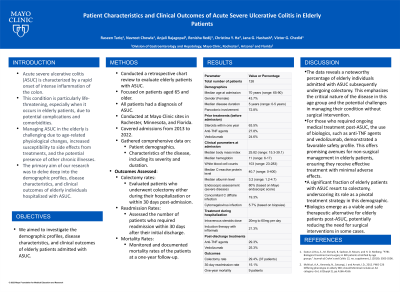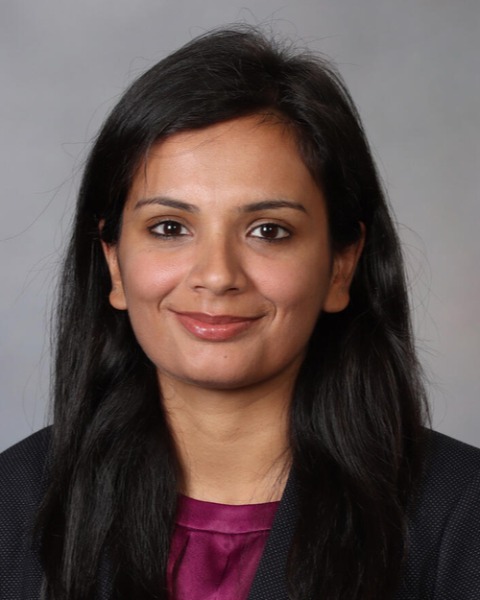Sunday Poster Session
Category: IBD
P0778 - Patient Characteristics and Clinical Outcomes of Acute Severe Ulcerative Colitis in Elderly Patients
Sunday, October 22, 2023
3:30 PM - 7:00 PM PT
Location: Exhibit Hall


Raseen Tariq, MBBS
Mayo Clinic
Rochester, MN
Presenting Author(s)
Raseen Tariq, MBBS1, Navreet M. Chowla, MD, FACG1, Anjali Rajagopal, MBBS1, Redij Renisha, MBBS2, Christina Ha, MD3, Jana G.. Hashash, MD, MSc, FACG4, Victor Chedid, MD, MS1
1Mayo Clinic, Rochester, MN; 2Mayo Clinic, Phoenix, AZ; 3Mayo Clinic Arizona, Scottsdale, AZ; 4Mayo Clinic, Jacksonville, FL
Introduction: Acute severe ulcerative colitis (ASUC) is a potentially life-threatening condition that poses significant challenges in the management of elderly patients. We aimed to investigate the demographic profiles, disease characteristics, and clinical outcomes of elderly patients admitted with ASUC.
Methods: A retrospective chart review was conducted for patients aged 65 and older and hospitalized for ASUC from 2013 to 2022 at three tertiary care hospitals. Data regarding patient demographics, disease characteristic sand outcomes such as colectomy rates during hospitalization or within 30 days were collected. Additionally, rates of readmission and mortality at one year were assessed.
Results: A total of 126 elderly patients with ASUC were included. Median age at admission was 70 years (range: 65-90), with 43.7% being female. Median disease duration was 5 years (range: 0-5 years), and 72.8% of patients had pancolonic involvement. Prior to admission, 63.5% of patients had received steroids within one year, while 27.8% had previously been treated with anti-tumor necrosis factor (TNF) agents and 24.6% with vedolizumab.
At admission, median body mass index was 25.82 (range: 15.3-39.1), median hemoglobin 11 (range: 6-17) and white blood cell counts 103 (range: 23-283). Median C-reactive protein level was 40.7 (range: 0-400) and median albumin level was 3.2 (range: 1.2-4.7). Endoscopic assessment of disease activity was performed in 110 patients, with 80% demonstrating severe disease based on the Mayo endoscopic score. Concomitant C difficile infection was present in 19.3% of patients, while 5.7% had evidence of cytomegalovirus infection based on biopsies.
Treatment during hospitalization consisted of intravenous steroids for all patients, with varying doses ranging from 20mg to 60mg per day and 21.3% received induction therapy with infliximab. Following discharge, 29.3% were started on anti-TNF agents, and 25.3% on vedolizumab. Overall colectomy rate, either during hospitalization or within 30 days, was 29.4% (37 patients). Additionally, 15.1% of patients required readmission within 30 days, and at one-year follow-up, 9 (5.5%) patients had died.
Discussion: A significant proportion of elderly patients admitted with ASUC underwent colectomy. Further studies are needed to identify predictors of colectomy in this vulnerable population.
Disclosures:
Raseen Tariq, MBBS1, Navreet M. Chowla, MD, FACG1, Anjali Rajagopal, MBBS1, Redij Renisha, MBBS2, Christina Ha, MD3, Jana G.. Hashash, MD, MSc, FACG4, Victor Chedid, MD, MS1. P0778 - Patient Characteristics and Clinical Outcomes of Acute Severe Ulcerative Colitis in Elderly Patients, ACG 2023 Annual Scientific Meeting Abstracts. Vancouver, BC, Canada: American College of Gastroenterology.
1Mayo Clinic, Rochester, MN; 2Mayo Clinic, Phoenix, AZ; 3Mayo Clinic Arizona, Scottsdale, AZ; 4Mayo Clinic, Jacksonville, FL
Introduction: Acute severe ulcerative colitis (ASUC) is a potentially life-threatening condition that poses significant challenges in the management of elderly patients. We aimed to investigate the demographic profiles, disease characteristics, and clinical outcomes of elderly patients admitted with ASUC.
Methods: A retrospective chart review was conducted for patients aged 65 and older and hospitalized for ASUC from 2013 to 2022 at three tertiary care hospitals. Data regarding patient demographics, disease characteristic sand outcomes such as colectomy rates during hospitalization or within 30 days were collected. Additionally, rates of readmission and mortality at one year were assessed.
Results: A total of 126 elderly patients with ASUC were included. Median age at admission was 70 years (range: 65-90), with 43.7% being female. Median disease duration was 5 years (range: 0-5 years), and 72.8% of patients had pancolonic involvement. Prior to admission, 63.5% of patients had received steroids within one year, while 27.8% had previously been treated with anti-tumor necrosis factor (TNF) agents and 24.6% with vedolizumab.
At admission, median body mass index was 25.82 (range: 15.3-39.1), median hemoglobin 11 (range: 6-17) and white blood cell counts 103 (range: 23-283). Median C-reactive protein level was 40.7 (range: 0-400) and median albumin level was 3.2 (range: 1.2-4.7). Endoscopic assessment of disease activity was performed in 110 patients, with 80% demonstrating severe disease based on the Mayo endoscopic score. Concomitant C difficile infection was present in 19.3% of patients, while 5.7% had evidence of cytomegalovirus infection based on biopsies.
Treatment during hospitalization consisted of intravenous steroids for all patients, with varying doses ranging from 20mg to 60mg per day and 21.3% received induction therapy with infliximab. Following discharge, 29.3% were started on anti-TNF agents, and 25.3% on vedolizumab. Overall colectomy rate, either during hospitalization or within 30 days, was 29.4% (37 patients). Additionally, 15.1% of patients required readmission within 30 days, and at one-year follow-up, 9 (5.5%) patients had died.
Discussion: A significant proportion of elderly patients admitted with ASUC underwent colectomy. Further studies are needed to identify predictors of colectomy in this vulnerable population.
Disclosures:
Raseen Tariq indicated no relevant financial relationships.
Navreet Chowla indicated no relevant financial relationships.
Anjali Rajagopal indicated no relevant financial relationships.
Redij Renisha indicated no relevant financial relationships.
Christina Ha: AbbVie – Advisory Committee/Board Member, Consultant, Grant/Research Support. Bristol-Myers Squibb – Advisory Committee/Board Member, Consultant. Helmsley Charitable Trust, – Grant/Research Support. Janssen – Advisory Committee/Board Member, Consultant. Lily – Advisory Committee/Board Member, Consultant. Pfizer Inc – Advisory Committee/Board Member, Consultant, Grant/Research Support. Roivant – Advisory Committee/Board Member, Consultant. Takeda – Advisory Committee/Board Member, Consultant.
Jana Hashash: Iterative Health – Grant/Research Support.
Victor Chedid indicated no relevant financial relationships.
Raseen Tariq, MBBS1, Navreet M. Chowla, MD, FACG1, Anjali Rajagopal, MBBS1, Redij Renisha, MBBS2, Christina Ha, MD3, Jana G.. Hashash, MD, MSc, FACG4, Victor Chedid, MD, MS1. P0778 - Patient Characteristics and Clinical Outcomes of Acute Severe Ulcerative Colitis in Elderly Patients, ACG 2023 Annual Scientific Meeting Abstracts. Vancouver, BC, Canada: American College of Gastroenterology.
